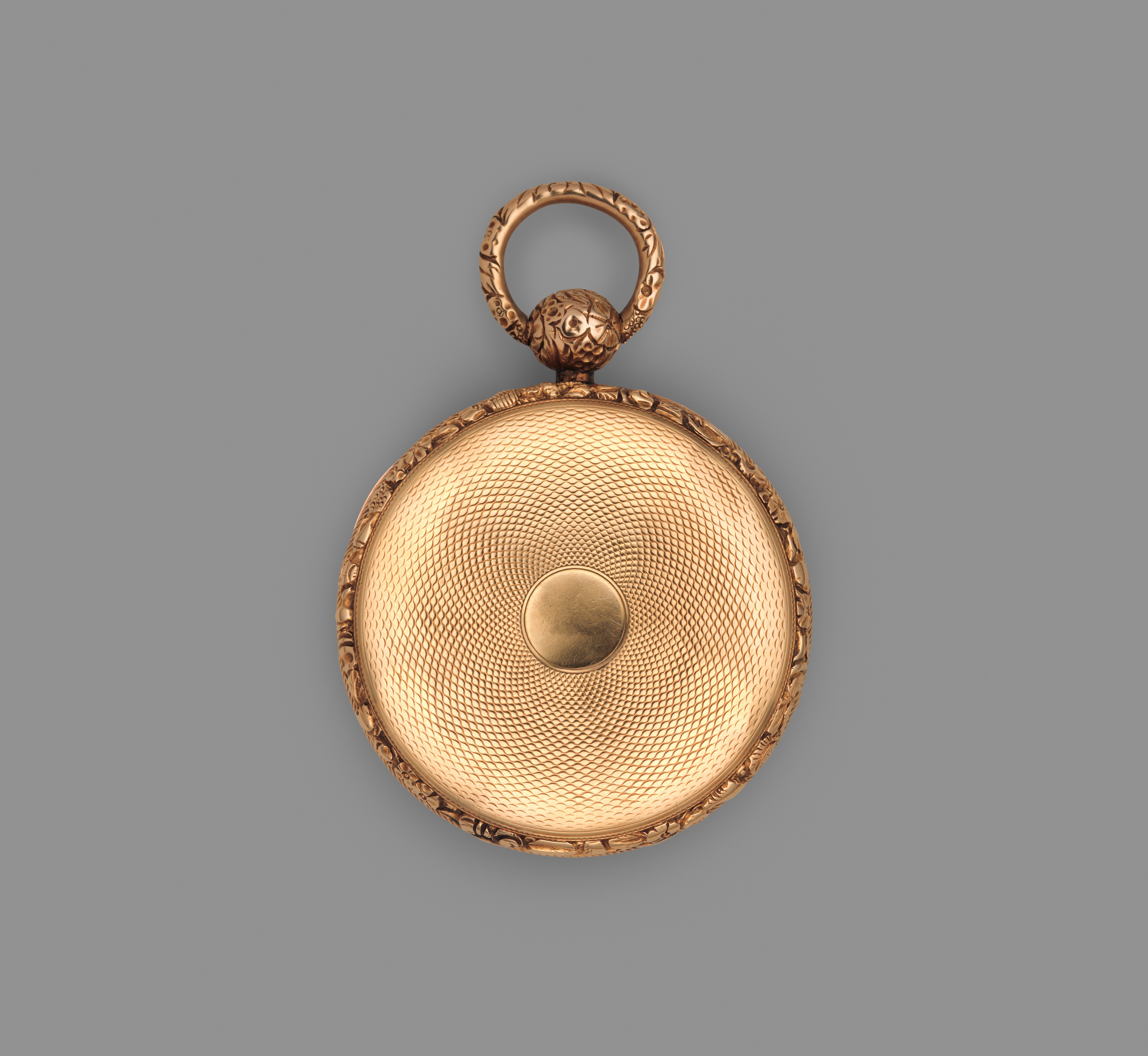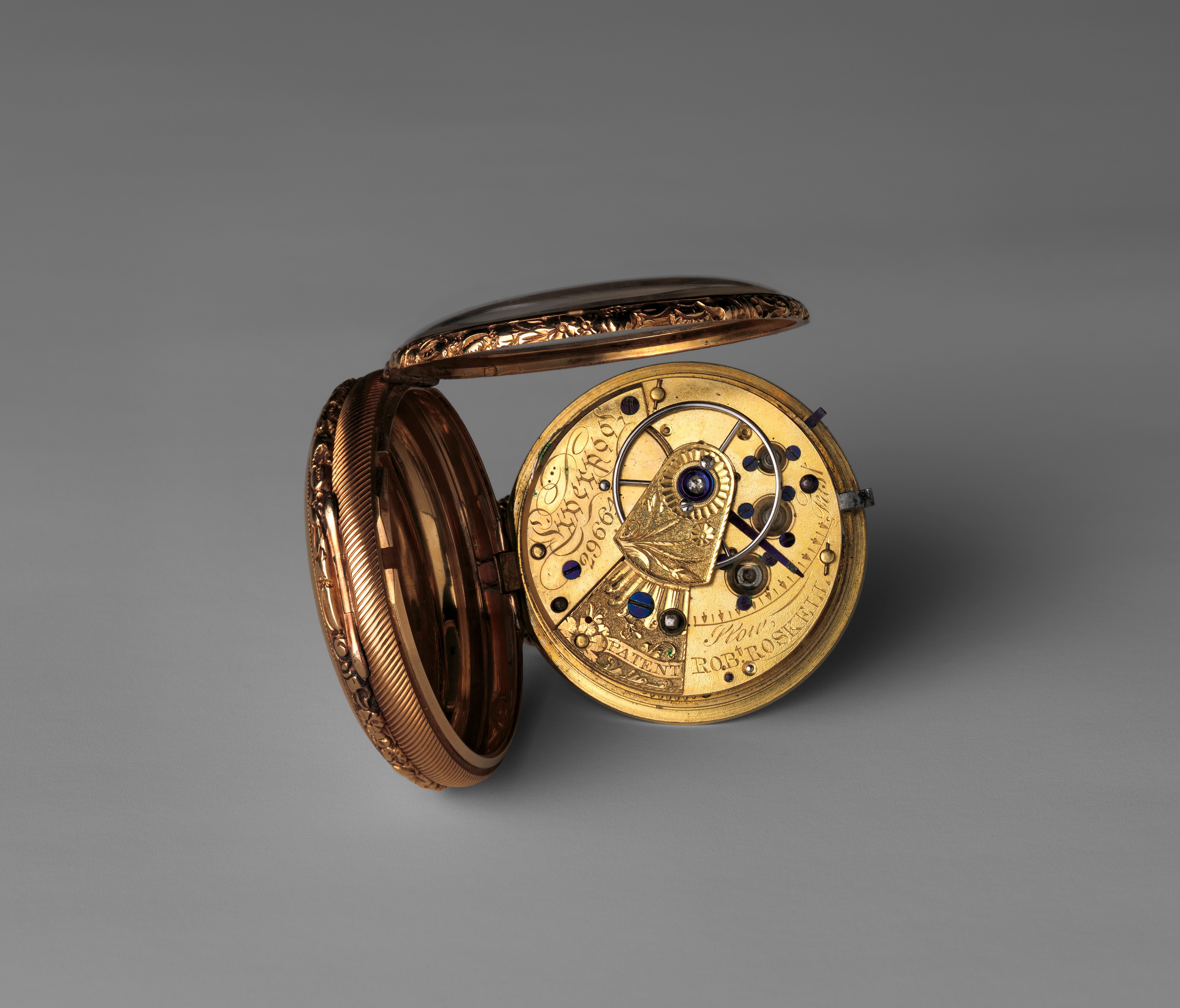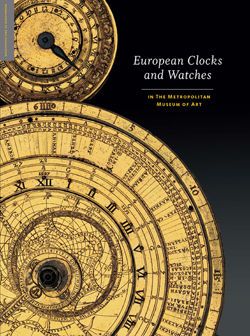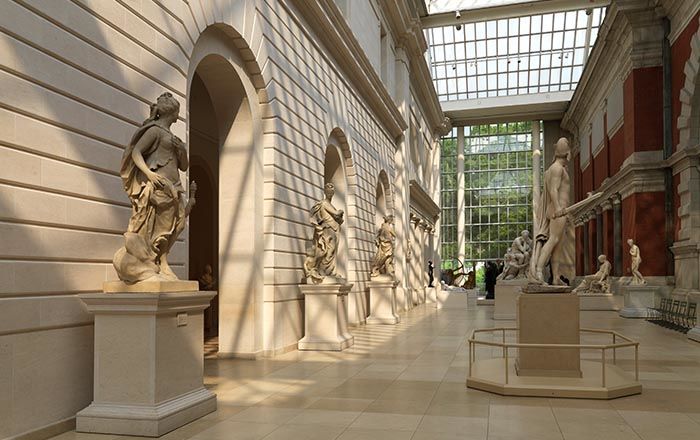Pocket watch
Watchmaker: Robert Roskell British
The rivalry in the eighteenth and nineteenth centuries between the watchmakers of the two major European watch-exporting nations, the British and the Swiss,[1] has been discussed at length by David S. Landes.[2] An economist with a deep interest in the history of watchmaking, Landes drew attention to the factors that he perceived as being responsible for nineteenth-century Swiss primacy despite major British and French contributions to technological improvements in both pocket watch and chronometer making.[3]
By the end of the eighteenth century, London makers of ordinary pocket watches had begun to lose ground to Swiss competition. The situation was made worse by the imposition of an annual tax by Parliament on watches and clocks in 1797.[4] The tax, promoted by King George III (1738–1820) and imposed by Prime Minister William Pitt the Younger (1759–1806), with the aim of financing Britain’s military engagement in the Napoleonic Wars (1803–15), only succeeded in rewarding a flourishing trade in smuggling. In addition, the tax managed to drive British possession of watches underground.[5] In 1802, a memorial to the Clockmakers’ Company’s Court of Assistants could state that the repeal of the tax in 1798, as well as the duty on gold and silver cases, put the “trade on the best footing to increase Home and Foreign Consumption.”[6] Concurrently, the increasing division of labor in the making of watches, together with a flood of émigré watchmakers (largely Swiss), had made many of the old rules of the Clockmakers’ Company obsolete; such rules, “considered hostile to the present mode of manufacturing watches . . . would decrease sales thereof as well as produce endless litigation & bring distress to a great number of useful and industrious Workmen.”[7]
An exception to this apparently distressed state of English watchmaking was to be found in early nineteenth-century Lancashire, where at least as far back as 1713 specialists had been making unfinished movements (blanks or ebauches) to be completed by London watchmakers. Watchmakers in Liverpool, the main city of Lancashire, adopted some of the newer practices of manufacturing,[8] and by about 1800, they were producing reliable watches in considerable quantity for a market that is believed to have consisted in no small part of merchants and manufacturers made remarkably prosperous by the flourishing industries in the British Midlands. One of the most successful of Lancashire watchmakers was Robert Roskell (active 1790–1847). Relatively little is known about his early life; some accounts are contradictory, and it is apparently uncertain when he was born. His early watches contain both lever and rack-lever escapements,[9] and in 1832, he patented a repeating mechanism.[10] Historian John Culme has traced Roskell’s partnerships in later life, first with Nicholas Roskell (partnership dissolved in 1832); afterward with his son Robert Roskell Jr. (died 1888) as Robert Roskell and Son, watchmakers and merchants, in Liverpool (dissolved in 1842); and with John Roskell Jr. (dissolved in 1847). After 1847, Robert Roskell Sr. disappears from Culme’s record, but Roskell and Company continued in Liverpool as a partnership between William Roskell and Richard Roskell, manufacturers and sellers of chronometers and watches, until 1877. By 1897 the firm had become Robert Roskell and Company Ltd., claiming to have been established in 1790,[11] presumably by Robert Roskell Sr.
In 1843, Robert Roskell Jr., following the dissolution of the partnership with his father, joined John Samuel Hunt (died 1865), a nephew by marriage of the highly successful London goldsmith Paul Storr (1771–1844), as a partner in the London firm that became Hunt and Roskell, jewelers, goldsmiths, and silversmiths to Queen Victoria (1819–1901).[12] Surviving watches signed “Hunt & Roskell” indicate that the firm also dealt in watches.[13]
The foot of the balance cock to the Robert Roskell watch in the Museum’s collection prominently displays the word “PATENT,” evidently referring to the rack-lever escapement. It is widely agreed, however, that the origin of the rack lever should be credited to a French mechanician, the Abbé Jean de Hautefeuille (1647–1724), who was also chaplain of the church of Saint Aignan in Orléans, France. Hautefeuille published his idea in 1722, an invention that is not to be confused with the detached lever escapement that Thomas Mudge (1715–1794), a former apprentice of George Graham (1673–1751), invented sometime about 1750.[14] Other forms of watch escapements, including various types of levers, proliferated in the course of the century [15] in continuing attempts to create a wholly recoilless escapement and, thus, a watch that was a better timekeeper.
Lever escapements in England had a different history than the varieties made on the Continent, but Hautefeuille’s rack lever was taken up not by French watchmakers but by Peter Litherland (1756–1804) in Liverpool, who obtained patents in 1791 and 1792 for two versions of the device.[16 ]His rack lever continued to be favored by Lancashire watchmakers, including Robert Roskell, until well into the nineteenth century. Roskell incorporated both rack levers and detached levers in watches that, like many others of the period, whether of Lancashire or London origin, are relatively substantial, retaining chain fusees and fullplate construction. These were in marked contrast to the fashionably thin watches with movements based on the inventions of Jean-Antoine Lépine (1720–1814) and Abraham-Louis Breguet (1747–1823),[17] which were being produced by French and Swiss watchmakers at this time.
The Museum’s watch is open-faced, the front cover consisting of glass within a circular gold bezel that is hinged to the band of the watch at the nine o’clock position. The dial and movement are hinged to the band at the twelve o’clock position and can be released by a spring at the six o’clock position. The back cover swings open at the twelve o’clock position to reveal a domelike piece, really the bottom of the case, through which the watch is wound. The exterior of the back cover is ornamented by a geometric pattern of engine-turned engraving,[18] the band is reeded, and the bezels, ball pendant, and ring are of cast and chased gold with an allover pattern of shell and floral ornament.
The dial provides the salient impression of the watch, however, with large roman numerals (I–V and VII–XII) of polished gold set against a fine matte gold ground and bordered by concentric circles of intricately fashioned vegetation in appropriate shades of white, blue, pink, and green made of gold alloys. The minutes are indicated by polished-gold dots that are located around the interior circumference of the hour chapter. The hands are made of gold: the hour hand with the so-called spade tip, and the minute hand with a finely proportioned baluster shape. A subsidiary dial for seconds in the six o’clock position (marked 10–60, by tens) has a polished gold chapter ring, an engine-turned center, and a needle-like steel hand. Altogether, the dial is easily read and creates a handsome effect, meriting its conspicuous display behind the glass cover.
The hallmarks on the case are those used for gold at the assay office in Chester during the years 1820–21. The incuse initials are those of the goldsmiths Thomas Helsby, or Hilsby,[19] and John Helsby (born 1796–died after 1891),[20] who are known to have worked in Liverpool until 1831 as “Watch-Case Manufacturers and Merchants,” after which time Thomas, with various members of the family doing business in Liverpool, as well as Argentina and Peru, declared bankruptcy.[21] John Helsby is believed to have used an incuse mark with his initials alone after about 1823 until at least 1871.[22]
The movement of the Museum’s watch consists of two gilded-brass plates, which are held apart by four cylindrical pillars. It contains a mainspring, a chain fusee, and a three-wheel train ending in a thre- armed steel balance wheel that is regulated by the rack lever. The back plate supports a solid balance cock marked “PATENT” on its foot, and the cock has a bell-shaped table that incorporates a diamond endstone for the pivoting of the balance’s arbor. The plate is engraved with a scale and has a hand for adjusting the balance spring. It is also engraved with the city name, Liverpool, the number 29664, and the watchmaker’s name “ROBT ROSKELL” that is repeated on the back of the case.[23] When in place, a protective dust cover for the movement that is fitted to the back plate permits a view of the bell-shaped table of the balance cock.
There are scratches in the areas of matte on the dial. The spring on the dust cover bears traces of rust. Otherwise, the watch is in excellent condition.
Notes (For key to shortened references see bibliography in Vincent and Leopold, European Clocks and Watches in the Metropolitan Museum of Art. NY: The Metropolitan Museum of Art, 2015)
[1] If, in the earlier years, we include the Genevan Republic as part of Switzerland.
[2] Landes 1983, chaps. 14–18.
[3] Ibid., pp. 300–301.
[4] Britten 1922, pp. 594, 595.
[5] Landes 1983, pp. 274–75.
[6] Clockmakers’ Company, London, Ms. 3951, no. 23, Guildhall Library, London. Among the rules felt to be obsolete was the requirement that the name engraved on a watch movement had to be the name of the actual maker.
[7] Ibid. For more about the state of British watchmaking at this time, see Weiss 1982, pp. 232–45.
[8] Ibid., p. 51.
[9] The Metropolitan Museum also has one of his watches with a detached lever escapement numbered 2056 and datable from the hallmarks to 1802 (acc. no. 10.24). It is perhaps the earliest surviving Roskell watch. See Shenton 1995, p. 77.
[10] T. C. Cuss 2009, p. 394.
[11] Culme 1987, vol. 1, p. 393.
[12] Ibid., p. 245.
[13] See T. C. Cuss 2009, p. 412, pl. 264, for a pocket watch hallmarked for 1877–78. See also Thompson 2008, p. 118.
[14] Much has been written about this complicated subject; see Thompson 2008, p. 98.
[15] For further information about these, see T. P. C. Cuss 1967, pp. 78–92; Britten 1978, pp. 190–99, for lever escapements; Britten 1982, pp. 188–95. For a wider variety of watch escapements, see Clutton and Daniels 1979, pp. 67–80. See also Tardy n.d., with numerous helpful diagrams.
[16] Mercer 1962; Clutton and Daniels 1979, p. 279.
[17] See entry 51 in this volume. See also Clutton and Daniels 1979, pp. 59–66. For more about Lepine, see Chapiro 1988; about Breguet, see Daniels 1975.
[18] For a brief discussion of the technique, as well as the lathes required for engine turning that were available in early nineteenth-century England, see Jagger 1988, pp. 86–87.
[19] Ridgway and Priestley 2004, pp. 410–11, nos. 8271, 2, and 8273. See also Priestley 1994, pp. 51–52.
[20] Ridgway and Priestley 2004, pp. 254–55.
[21] London Gazette, Feb. 28, 1832, p. 454.
[22] Ridgway and Priestley 2004, p. 255, no. 4819.
[23] For an attempted correlation between known numbered Roskell watches and hallmarked dates on their cases, see D. M. W. Evans 1976.
This image cannot be enlarged, viewed at full screen, or downloaded.
This artwork is meant to be viewed from right to left. Scroll left to view more.





